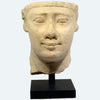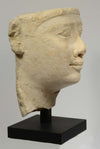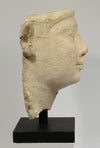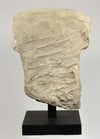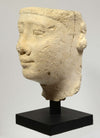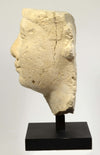15195
Early Ptolemaic Period, circa 305-200 B.C.
A sculptors model with handsome idealized features with full modeled face, fleshy lips rounded at the corners, contoured eyelids, and eyebrows in relief. Smooth forehead and delineation of wig. Size: 9 inches (23 cm) Height + custom mount.
The Ancient Mediterranean and Near East were forever shaped by the Macedonian king who conquered their regions to create one of the largest empires in history. However, a crisis struck when Alexander III died without any heirs. After warfare and inner fighting, his generals divided his empire amongst themselves; Cassander got Macedonia and much of Greece, Lysimachus had parts of Turkey, Seleucus got Central Asia and the Middle East, and Ptolemy ruled Egypt. In 305 BC, the Ptolemaic Dynasty, the last of the 33 Egyptian dynasties that would span 2700 years, began.
Interpretations on the nature of the Ptolemaic rule differ from Edouard Will who argues it was a colonial settlement to Joseph Manning and Johann Gustav Droysen who think that it was a fusion of Eastern, Western, pharaonic, Greek and Persian cultures. Regardless, it is undeniable that there were transformations in the economic, social, and political system of the Egyptian state during the 275 year Ptolemaic reign. During their reign, the Ptolemy's attempted to assimilate into Egyptian culture, or at least appropriated the traditions of previous dynasties, by intermarrying and depicting themselves in the style of the pharaohs. Although the degree of cultural blending, especially across regions and classes, is opaque, at an artistic level, there was a hybridization of traditional Egyptian, Hellenistic, and Roman styles that is especially evident in royal and private statues.
Across many cultures, it was common for an artist to use a mold or model to save time and ensure continuity amongst their products from sculptures to reliefs to metalwork. This technique was employed throughout the Mediterranean, notably with the Greeks and Romans, who used models, like the Doryphorus, to stick to their canon. Modeling techniques existed in Egypt since the Old Kingdom when plaster was modeled over the linen wrapping of mummies. During the Ptolemaic dynasty, the faces of kings were a popular subject for sculptor's models to ensure the production of even three-dimensional sculptures, and it is speculated that these models may have also served as votive offerings since many have been found in temples.
With a rounded rectangular face, smiling lips, and friendly eyes, this stucco modeled head of a pharaoh (305-200 BC) has a soft and inviting face. The wide, fleshy nose, cheeks, and chin are representative of portraits of the Thirtieth Dynasty and Ptolemaic periods. The head’s full lips, simple carved almond eyes, and rounder face reflect characteristics of Egyptian art, while the slight definition in his cheekbones and face shape is reminiscent of Greco-Roman statuary facial features.
Although cut off, the raised band above his head suggests that the statue was likely adorned with a headdress, probably a Nemes, which most Egyptian pharaohs were depicted in–a tradition that the Ptolemaic pharaohs continued. Also cut off, portions of the head’s large ears remain, which were popular characteristics during the Ptolemaic period. While it is not known which pharaoh this model represents, the style and facial features bear much resemblance to the statue of King Ptolemy II (No. 96; Pl. 90, Figs. 239-241.).
Caught between the colonization of two Mediterranean empires, and a declining empire itself, the Ptolemaic dynasty was a fascinating period of Egyptian history with its mix of cultures and traditions and position in Mediterranean politics. The facial features and the modeling technique of this stucco model head represent the fusion of Hellenistic and traditional Egyptian styles in the early Ptolemaic dynasty. A head like this would have been disseminated throughout the empire to establish a communal connection to the Greek ruler. His image would soon become known by members of the community, and the possession of such a portrait would mark a connection with the individual depicted. The pharaoh would also be depicted on money (coinage), thus helping to spread social continuity and economic stability.
This head of a Ptolemy is one of the few surviving real life depictions of an Egyptian pharaoh, only made more unique by its blend of Egyptian techniques and Hellenistic three-dimensionality. More than two thousand years later, the head still exudes the divinity and importance of its subject.
Bibliography:
Bothmer, Bernard V., comp. Egyptian Sculpture of the Late Period 700 B.C. to A.D. 100. 2nd ed. New York, NY: The Brooklyn Museum, 1973.
Cafici, Giorgia. Looking at the Egyptian Elite: Sculptural Production of the Ptolemaic Period. Egitto e Vicino Oriente 37 (2014): 111–21. http://www.jstor.org/stable/24324128.
Fazzini, Richard A. Cleopatra's Egypt: Age of the Ptolemies. New York, NY: The Brooklyn Museum, 1988.
Provenance: Axel Vervoordt 2017; acquired from Galerie Chenel, Paris; English private collection, before 1997 (published in a 1997 Richard Philip catalogue) David Aaron, London, 2015.
All pieces are unconditionally guaranteed authentic and as described in perpetuity and have been legally acquired and imported in full accordance with U.S. and applicable foreign regulations regarding the movement and sale of antiquities.
A signed guarantee of authenticity with a description and photograph of the item(s) accompanies this object.
We ship Tuesday to Friday with UPS or USPS and usually same day if your order is received before 2pm. Depending on size and destination, delivery times range from one to five business days.
For overseas shipments our shipping charge includes packing, preparation of all customs paperwork, insurance and carrier fees in compliance with all USA and International customs requirements.
Overseas shipments are usually sent by courier but contact us if you have a shipping preference. International customers are responsible for all duties and taxes.


